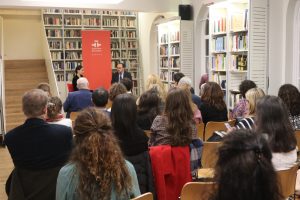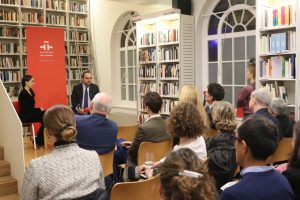Tamara Rojo highlights the contribution of Spanish immigration to London

Dancer and director of the English National Ballet, Tamara Rojo, highlighted the contribution of Spanish immigration to London during her participation in a meeting of the new series of White-White Dialogues, in a conversation with the director of the Cervantes Institute in London, Ignacio Peyró.
The prestigious dancer reviewed her extraordinary artistic career and talked about the world of dance, her sacrifices and her successes, as well as the career of a Spanish woman who has triumphed in the British world.
Rojo came to London 22 years ago and remembers that everything was closed on Sundays and at six in the afternoon. But he acknowledges that he has now become a much more cosmopolitan city and part of that has been due to the contribution of Spanish immigration.
“Obviously, for me that is a pleasure. Above all, in gastronomy, because it must be recognised that British gastronomy, 20 years ago, did not have a high quality. The influence that there are so many Spanish restaurants here, so many business circles of Spanish people, artists and people that I can deal with, I think is something very positive,” she added.

London: cultural capital of the world
For Rojo, London right now is the cultural capital of the world, because it contains a little bit of everything. “That is one of the main reasons why I love living here. As an artist, I love meeting artists and works of all kinds. It is a constant source of inspiration. The only stressful thing about London is that there is not enough time in the year to see everything there is,” explained Rojo.
The dancer recognises that her dreams have evolved. When she arrived here she wanted to be a dancer, then a prima ballerina and finally to perform and work for the The Royal Ballet. Right now, she has been artistic director for the English National Ballet for seven years, and she believes that this year is the completion of her original vision she envisaged when she first took the role. Namely, Rojo has moved the National Ballet to new facilities, being invited by theatres such as the Bolshoi in Moscow or the Paris Opera, with an international reputation, and with the works they have created.
New challenges
“Let’s say that, finally, the company is now what I thought it could be. Obviously, up to a point, now the best comes, the icing. I still have many things to do,” she says. Among those challenges is to reinterpret the classics, not only in a contemporary way, but also with a classical vocabulary, to make the company financially more and more independent and secure: “It’s nothing totally new, but an expansion of our vision, which I feel that only now we have achieved”.
The White-White Dialogues bring great characters related to Spanish culture and relations between Britain and Spain to the British public. In a relaxed and relaxed atmosphere, prone to confidences, Rojo opened this new format with an in-depth conversation, open to the public, in the library of the Cervantes Institute in London.

“We are in a very complicated moment with Brexit. Not only for me personally or for in English National Ballet, but also for all creative industries,” defended the dancer. In the first place, she believes that this will be the case for the creative industries, since both London and the United Kingdom feed on the freedom of movement of individuals and also of materials.
“Many British musicians survive thanks to coming and going to Europe. Also co-productions, festivals, touring Europe without paying different taxes for sets and costumes. The expense, the time, the visas… For us it will be bad, but for companies of less resources and individual artists it can be lethal”, Rojo recognizes.
Relevance of the White-White Dialogues
Peyró highlighted the relevance of these dialogues to deepen the ties that unite both countries, in a cycle that in the coming months will also feature the presence of the writer and Cervantes 2016 award winner Eduardo Mendoza, chef Jose Pizarro and the journalist, writer and businessman Juan Luis Cebrián, among others.
«We want to offer, above all to our Spanish students, access to relevant personalities and with great experience, which, in this environment of confidence, can bring them closer to culture and language,» Peyró said.


